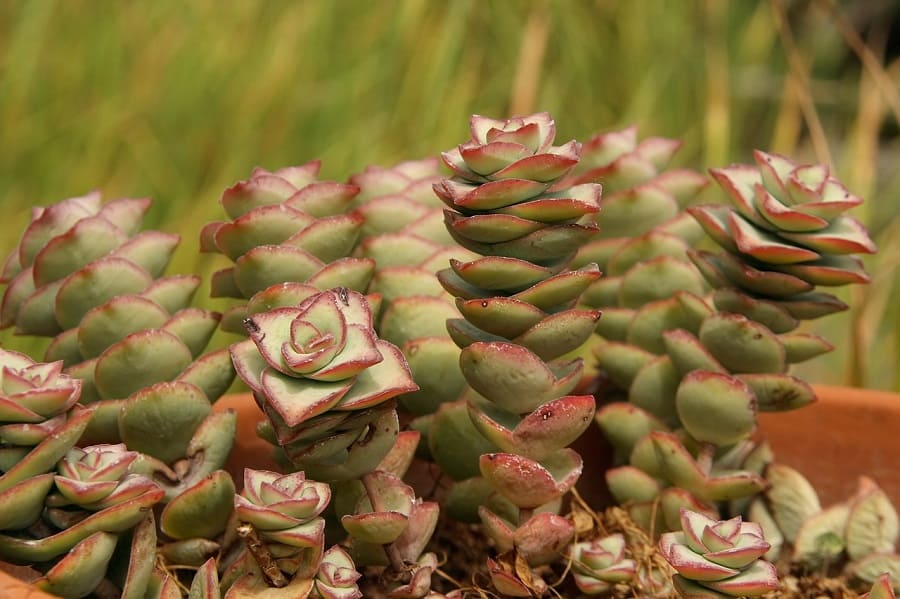Crassula ‘Baby Necklace’ is a very pretty little succulent. Its leaves are swollen green with red edges, the stems are thin, and it gives the appearance of a necklace (from there is its name).
The Crassula ‘Baby Necklace’ can measure up to 30 cm high and 30 cm wide.
The flowers are white; you can enjoy the beautiful flowers from spring to summer.
This plant is perfect for indoors, especially if you don’t have enough space.
Crassula ‘Baby’s Necklace’ Care
Substrate:
This succulent requires a substrate that allows the water to drain as well as possible. You can use a specific substrate for cacti and succulents.
If you want to have it in your garden, the soil has to have good drainage and a neutral or slightly alkaline pH.
Since it doesn’t grow much, you can dig a hole of about 40cm x 40cm, fill it with the above-mentioned substrate.
You can also mix the soil in your garden with coarse sand, pumice, and/or perlite.
Watering:
Irrigation should be rather poor. The substrate must dry completely between waterings to prevent the roots from rotting.
In summer you can water twice a week and in winter every 15 days or once a month.
When watering, do not wet the leaves, only the substrate. Doing so can cause the leaves to rot. Also, if the plant is in the sun and you wet the leaves, it can cause the leaves to burn faster.
You may like: Dischidia nummularia
Temperature:
The ideal temperature is warm. The ideal range is between 20ºC/68°F to 35ºC/95°F. It tolerates low temperatures as long as the substrate is completely dry.
The combination of cold with humid environments causes the stem and root to rot quickly.
Illumination:
This plant thrives much better if it is exposed to direct sunlight, but only for a few hours. You have to avoid leaves burn.
It’s recommended to provide 3-6 hours of sun daily so that it can flourish.
Indoors you must provide intense artificial light; under artificial light, it grows slowly.
Fertilizer:
This plant does not need many nutrients for its development, so if you fertilize once a month, it will be more than enough and only in the summer season.
Diseases:
It’s quite resistant to pest and disease.
During the rainy season, watch out for mollusks (snails and slugs), since these animals tend to eat succulents and other tender plants.
Transplant:
The transplant should be done only in spring. If you have it in a pot, change it to a bigger pot every two or three years.
Transplant the succulent into the new pot:
Fill the new pot approximately 1/3 of its depth with a new mix for cacti and succulents.
You can put a mesh or the typical piece of broken pot over the drain hole to prevent the soil from falling, but it is not necessary.
Place the succulent on the ground and then, while holding the plant in place, fill the pot with mixture 1 or 2 centimeters below the edge.
None of the stems of the plant must be below the ground, only roots.
Compact the soil lightly to keep it in place.
Propagation:
The crassula ‘baby’s necklace’ is reproduced through a stem or leaf cut.
In their natural habitat, it is usual for the stems and leaves to detach on their own, and a few weeks later, they begin to form new plants.
To reproduce the crassula ‘baby’s necklace’ at home, you can take a stem or leaf cut using a sharp knife and cut.
It is recommended to wait for the cutting to dry for a few days. This way, you avoid that it absorbs too much water and rots.
You must prepare a substrate with good drainage. Once you have it ready and the cutting wound has dried, you should bury it in the substrate.
Once planted, only water when the substrate is completely dry.
Since the crassula ‘baby’s necklace’ is a fast-growing plant, you will start to see results in a few weeks.
Pruning:
It does not require pruning; it only removes dry leaves or those affected by a pest, to prevent the disease from spreading.
